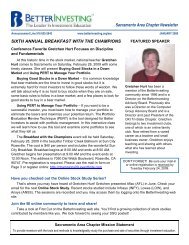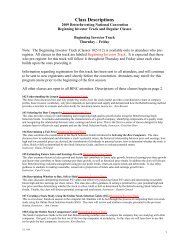STOCK TO STUDY: T. Rowe Price Group, Inc ... - BetterInvesting
STOCK TO STUDY: T. Rowe Price Group, Inc ... - BetterInvesting
STOCK TO STUDY: T. Rowe Price Group, Inc ... - BetterInvesting
You also want an ePaper? Increase the reach of your titles
YUMPU automatically turns print PDFs into web optimized ePapers that Google loves.
FEATURE | Cover Story<br />
Titles such as “new explorer” might<br />
be code for “really risky speculative<br />
invest ments.” If that’s what you’re<br />
looking for, fine, but be sure you<br />
understand what’s behind the name.<br />
8. Don’t Just Set It and Forget It<br />
In any given year, some of your funds<br />
will do better and some worse. To<br />
maintain your portfolio’s balance (and<br />
risk level), once a year you should<br />
rebalance back to your original targets<br />
by selling shares in any that exceed<br />
your target and purchasing shares in<br />
those that have fallen below your target<br />
percentages.<br />
Although it may seem counter -<br />
intuitive to buy more of the “losers,”<br />
in the long run you’ll be buying low<br />
and selling high. Over time, studies<br />
have shown that annual rebalancing<br />
offers about a half-percent return premium<br />
over not rebalancing.<br />
In markets in which one asset is<br />
booming, you can end up with a<br />
much more risky portfolio if you<br />
don’t rebalance.<br />
9. Understand What Share<br />
Classes Are Offered<br />
Share classes can designate several<br />
things. For load funds, share classes<br />
such as A, B or C can designate how<br />
commissions are charged: upfront,<br />
upon sale or disappearing after you’ve<br />
held shares for a certain per iod. If you<br />
do buy load funds, be sure you understand<br />
how much, how frequently and<br />
when the load will be assessed.<br />
For no-load funds, share classes<br />
can be based on required minimum<br />
investments. For example, Vanguard’s<br />
Investor class shares generally require<br />
a $3,000 minimum investment, while<br />
the Admiral class may require a $10,000<br />
minimum or more but charges only<br />
half the management fee. Other share<br />
classes may be available only to investment<br />
managers or be specific to em -<br />
ployer-sponsored plans. Know what<br />
those terms and letters mean to your<br />
costs and returns. Funds are mentioned<br />
only for educational purposes.<br />
No investment recommendations<br />
are intended.<br />
10. Invest in Knowledge<br />
<strong>BetterInvesting</strong> always offers regular<br />
features on mutual fund investing, as<br />
well as the recently revised Mutual<br />
Fund Handbook and online mutual<br />
fund tools. Morningstar.com and each<br />
fund company’s own website can offer<br />
plenty of facts, figures and comparisons<br />
to allow you to drill down to the<br />
details you need.<br />
Investing in mutual funds may not<br />
be as easy as it first seems, but with<br />
some thoughtful research, you can<br />
build a solid core of well-diversified<br />
investments that can manage your<br />
risk while producing good return.<br />
Danielle L. Schultz, CFP, CDFA, is a feeonly<br />
financial planner and investment<br />
adviser in Evanston, Ill. Contact her at<br />
www.HavenFinancialSolutions.com.<br />
Websites of Interest<br />
The <strong>BetterInvesting</strong> Mutual Fund<br />
Handbook, revised by Danielle L. Schultz<br />
www.betterinvesting.org/Public/Store/<br />
Store/Books/default.htm<br />
42 | <strong>BetterInvesting</strong> | March 2013





